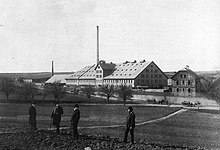Böckingen brickworks
The Böckinger Ziegelei was a brick factory in Böckingen that was founded in the 1870s by the Heilbronn construction company and soon became the company's main business purpose. The company initially benefited from the building boom of the Wilhelminian era and, after the economically difficult years of the First World War and the inflationary period, merged with the brickworks in Neckargartach , which was closed a few years later. The reconstruction after the Second World War led to another flourishing of the company, before it was taken over by a competitor in 1971 and also perished with its bankruptcy in 1983.
The public brickworks park is located on the former premises of the Böckinger Ziegelei . Many of the historic buildings in Böckingen and the surrounding villages that were built with bricks from Böckingen's production also remind of the brickworks.
history
After winning the German-French war was in April 1872 under the leadership of Rümelin Bank and with the participation of the paper manufacturer Adolf of smoke and Gustav Schäuffelen the construction company Heilbronn founded as a construction business for residential and industrial construction. When it was founded, the banker Max Rümelin was chairman of the supervisory board, and Adolf Otto was chairman of the board . The company included a sandstone quarry and a gravel and sand pit. After a short time, a machine brickwork was also built in which initially only bricks and later roof tiles were produced. The company also had a cement plant in Ubstadt . Until 1896, the business area was then limited to real estate business in Heilbronn and the operation of the brickworks. In 1914 the company had 72 employees.
In 1923 the construction company merged with the Dampfziegelei in Neckargartach , which was founded in 1898 and which was in dire straits due to the war economy of the First World War and the inflationary period. The brick factory in Böckingen was rebuilt and modernized in 1926/27. Due to a lack of raw materials and sales problems, the Neckargartach brickworks, where 60 people were last employed, were given up in 1930. The factory buildings were demolished in 1936. During the Second World War, the company, called Ziegelwerke Heilbronn-Böckingen AG since 1937, had to restrict its production in Böckingen and stop it entirely as the war progressed.
After the currency reform, the Böckinger brickworks was modernized again and benefited from the high demand for bricks that resulted from the reconstruction of the destroyed buildings in the surrounding areas. By 1960 the company had 160 employees. The largest shareholder was the Portland cement plant in Lauffen am Neckar . In 1971 the main competitor, the Weinsberg brickworks Koch & Sons, acquired the majority share. The previous Böckinger Aktiengesellschaft was then dissolved in 1975 and the company converted into a GmbH . The main shareholders of the Heilbronn-Böckingen GmbH brickworks were Koch & Sons with more than 98% of the capital. In 1977 the company was renamed Böckinger Ziegel GmbH .
The bankruptcy of Koch & Sons in 1983 also led to the end of the Böckinger brickworks. The 16 hectare site came into the possession of the city of Heilbronn via a foreclosure auction in 1985. The Böckingen company was deleted from the commercial register in 1988, and the former factory premises of the brickworks were redesigned as a brickworks park by 1995 . The 10-meter-high loess wall on the former company premises, which was created by the brickworks dismantling, was declared a two-dimensional natural monument together with a 40-meter-wide protective strip in front of it in 1991.
Buildings that were built with Böckingen bricks have been preserved, especially in Böckingen, but also in numerous surrounding towns, including the listed ensemble Eppinger Str. 47 , 49 , 51 , 64 , 66 , 68 and 72 in Böckingen and that earlier in Heilbronner Semi-detached house in the red light district Sontheimer Straße 3/5 in Heilbronn.
Individual evidence
- ↑ Jürg Arnold: Adolf Otto (1827–1898): Lawyer and business citizen . In: Heilbronner Köpf V (2009), pp. 149–170. Heilbronn Verlag Stadtarchiv 2009 (Small series of publications by the Heilbronn City Archives; 56), see p. 163.
literature
- Christhard Schrenk, Hubert Weckbach: "... for your account and risk". Invoices and letterheads from Heilbronn companies . Heilbronn City Archives, Heilbronn 1994, ISBN 3-928990-48-9 ( Small series of publications by the Heilbronn City Archives. Volume 30), pp. 18/19.
Web links
Coordinates: 49 ° 7 '58.5 " N , 9 ° 10' 44" E


